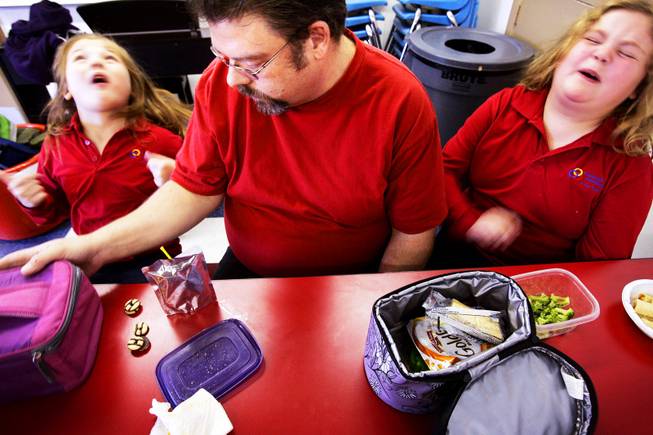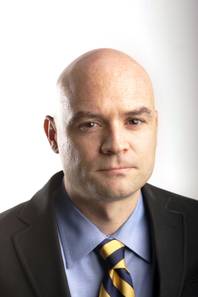
College of Southern Nevada student Terry Spieker eats lunch with his autistic daughters Jillie, left, 7, and Lexie, 9, at the Bridge Program at Cumorah Academy, a special program for autistic children that opened last year. The school’s opening has allowed Terry the time to go back to school for nursing.
Friday, March 11, 2011 | 2:01 a.m.
View more of the Sun's opinion section

J. Patrick Coolican
Sun archives
- UNLV president presents cuts, says they are “a tragic loss and a giant step backward for Nevada” (3-8-2011)
- UNLV president’s somber warning on budget cuts moves faculty to tears (2-16-2011)
- Regent says it’s time that K-12 shares in budget sacrifice (2-8-2011)
- Higher education officials say Sandoval budget cuts a ‘death sentence’ (2-4-2011)
- Education in forefront of upcoming budget battle (1-30-2011)
- Chancellor: University tuition would have to go up 73 percent to cover Sandoval budget gap (1-27-2011)
- A steep climb for Nevadans (1-26-2011)
- Soft words during State of the State hide Nevada in pain (1-25-2011)
There seems to be a misconception out there that when we talk about supporting higher education we’re talking about fraternity boys playing beer pong or guys in tweed coats smoking pipes and ruminating about Dostoevsky.
There’s perfectly good justification for those aspects of university life, as the fortunate sons and daughters of Nevada privilege can attest. But the reality is that our higher ed system is mostly geared toward getting large numbers of nontraditional students the basic skills and training they need to get jobs.
Of the 114,000 students in the Nevada System of Higher Education, for instance, 44,000 of them last fall were students at the College of Southern Nevada.
Let’s meet some.
Terry Spieker, 44, has a wife and three children, including two girls, ages 9 and 7, who are severely autistic.
When he came here from Cleveland in 1996 to be closer to family, he got into property management. He did that for 12 years, which, given the real estate boom, was a good business.
In 2008, a combination of the real estate collapse and his decision to focus more on caring for his daughters left him jobless.
Last fall he enrolled at CSN to pursue a degree in nursing. He’ll need two semesters of prerequisites, and then four semesters of nursing, which will include class work, labs and clinical practice.
Spieker’s wife is a nurse, and for now, they’re living on her income. His mother, who died last year, left him enough money for tuition for two semesters. He’s hoping for financial aid for the fall. This semester has been tough because he’s taking anatomy and physiology, but overall his GPA is 3.8.
The girls are happy, and they’re doing better since Spieker is home more, but they require intense therapy costing $70,000 a year, Spieker says. They get a little help from the state, and the girls go to a special school, but there are significant out-of-pocket costs. Spieker says they lost their home.
“We said, ‘What’s more important? Having a house? Or having a better future?’ And that’s one of the reasons I’m going into nursing: I can put time and money into their future. My goal is to pay for them when I’m not around to take care of them anymore,” Spieker says.
More than half of CSN’s students are 25 and older, and the average age is 28. One-quarter of the students are Hispanic, and we can surmise that for many, they are the first generation of their families to attend an institution of higher education. According to an internal survey, more than one quarter of 1,507 respondents reported having been laid off in the past three years.
Gov. Brian Sandoval’s budget, which would cut higher education overall by 17 percent, would take $26.7 million, or 29 percent of state support, from CSN.
Nikki Anderson, 24, is an executive assistant for two airlines. She’s been married seven years, has two children, ages 6 and 3, and is pregnant with a third. Her husband, a truck driver, was laid off, but recently found work.
In 2008, she went back to school and is majoring in English. She’ll transfer to UNLV and hopes eventually to go to law school there and then become a Family Court judge. When you listen to her, you just know it’s going to happen.
Anderson is afraid of debt, so she and her family live no-frills so she can keep going to school: “I live by a strict budget. My husband and I decided education is important and that’s going at the top of the list.”
Did I mention she’s pregnant?
I’m lucky enough in this job to meet people whose drive, in the face of adversity and child rearing and work and school, is flat-out remarkable, and the question that always strikes me: How do you do it?
“I don’t get a lot of sleep. I lived off Diet Coke before I got pregnant. You just do it. You just have to focus,” Anderson says.
And then: “I can’t look at my two daughters and say, ‘Do your best,’ if I’m not doing my best.”
The current average annual base salary for full-time faculty is $63,745. The workload for full-time faculty is five classes per semester. Part-time faculty get $2,403 for teaching a three-credit class.
Maya Culverson, 29, has three children and wants to be a nurse. She’s a server at Buca di Beppo, but when the economy went down, she realized it was time for a career rather than just a job.
She’s been doing well at CSN for two years, but the problem is that she can’t get into a biology class that is a prerequisite for nursing. So she waits.
“It’s a big mess,” she says.
Culverson studies when the children, ages 3, 9 and 13, go to sleep, but tries to cut herself off at 2 a.m. Caffeine makes her jittery, so for energy she runs when she can and takes vitamins.
Culverson is not alone among students who can’t get classes. Last fall, 5,300 students tried to enroll in classes, couldn’t get in and walked away from CSN. The college spokeswoman, K.C. Brekken, says, “We don’t know what has happened to these students, where they went or if they even continued to pursue higher education.”
If the budget as proposed by Sandoval is approved, students, who have seen tuition spike 26 percent since 2007-08, can expect another hefty increase.
If we’re lucky, the tuition increase will discourage people from enrolling. Then we can shut the place down and save ourselves a bunch of money.
By that time, the price of gold will have plunged and our out-of-state mining corporations will be in need of a tax cut.
Coolican’s column runs Tuesdays and Fridays.


Join the Discussion:
Check this out for a full explanation of our conversion to the LiveFyre commenting system and instructions on how to sign up for an account.
Full comments policy